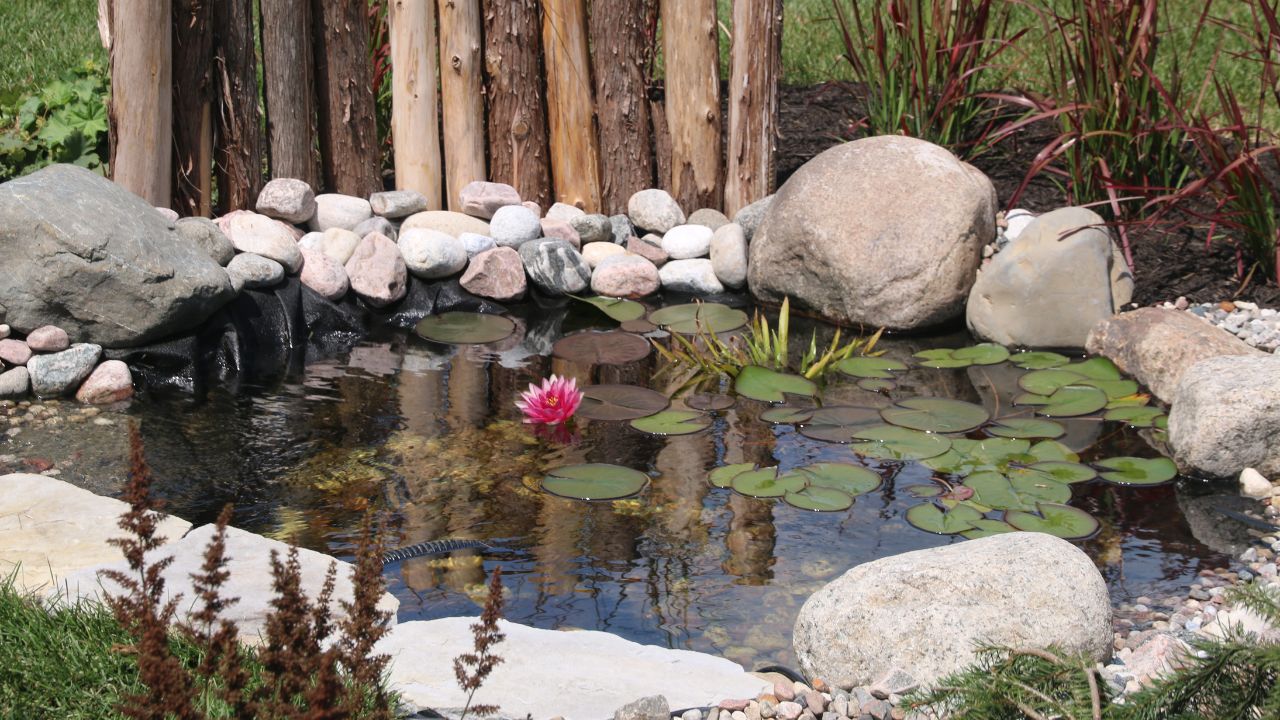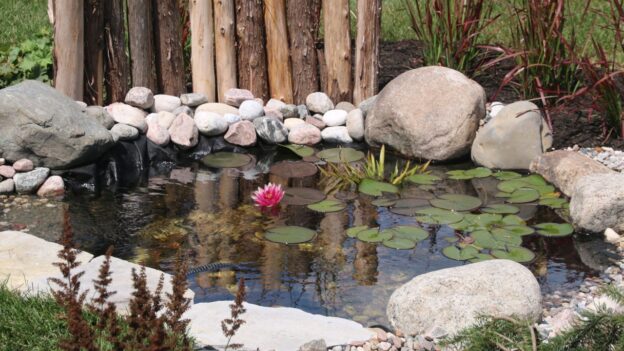
Key Takeaways:
- Beat algae – Add plants, limit fish food, and use treatments.
- Clear cloudy water – Clean filters and check pump flow.
- Find leaks fast – Watch water levels and patch cracks early.
- Keep pumps running – Remove debris and replace worn parts.
- Test water often – Balance nutrients and oxygen for healthy fish.
Having a pond or fountain in your backyard can turn your outdoor living space into a peaceful retreat. But let’s be honest—owning a pond isn’t always smooth sailing. Sometimes, things go wrong, and when they do, it’s good to know how to fix common pond problems. Whether you’re dealing with algae growth, murky water, or a malfunctioning pump, we’ve got you covered. Here are some of the most common pond problems and how to tackle them like a pro.
Algae Growth – The Green Menace
Algae is probably the biggest headache for pond owners. A little bit is normal, but when it takes over, your clear water turns into a green swamp. Algae blooms happen when there’s too much sunlight and excess nutrients in the water. If you’ve got fish like Koi, overfeeding them can make the problem worse because leftover food breaks down and feeds the algae.
To control algae, start by adding more aquatic plants. They compete with algae for nutrients and help keep the water balanced. If that’s not enough, consider an algae control treatment or a UV clarifier. Regular maintenance, like cleaning debris and avoiding overfeeding, also goes a long way. And if you’re in Orange County, where the sun is strong, shade from floating plants or a small canopy can help reduce algae growth.
Cloudy or Murky Water – What’s Going On?
Nobody likes a pond that looks like a mud puddle. Cloudy water can be caused by a few things—suspended dirt, decaying plants, or even fish stirring up the bottom. Poor water quality is often the culprit. If your pond is new, the cloudiness might just be settling dust, but if it’s an ongoing issue, you’ll need to take action.
First, check your pond filtration system. A good filter should clear up the water in no time. If you’re using submersible pumps, make sure they’re working properly. Sometimes, all it takes is a quick filtration backwashing to get things flowing smoothly again. For stubborn cases, a water clarifier can help bind tiny particles together so the filter can catch them.
Leaks – Where’s All the Water Going?
If your pond’s water level keeps dropping faster than usual, you might have a leak. Water loss can happen from cracks in the liner, loose fittings, or even evaporation (especially in Southern California’s heat). To find the leak, let the water drop until it stops—that’s where the problem is.
Small leaks in flexible liners can be patched up with a repair kit. For larger issues, especially in pond construction, you might need professional help. If you’re not sure where the leak is coming from, the team at Orange County Pond Services can help track it down and fix it for good.
Fountain or Pump Problems – When the Water Stops Flowing
Nothing kills the vibe of a beautiful garden fountain like a pump that won’t turn on. If your outdoor fountain suddenly stops working, check for clogs first. Debris like leaves or dirt can block the impeller. Cleaning it out might solve the problem.
If the pump is running but the water flow is weak, it could be a sign of wear and tear. Pond pumps don’t last forever, especially if they’re running 24/7. Sometimes, replacing a worn-out part is all it takes. For wall fountains or commercial fountains, regular Fountain Maintenance can prevent bigger issues down the line.
Poor Water Quality – Keeping Your Pond Healthy
A healthy pond is all about balance. If your fish seem stressed or the water smells funky, it’s time to test the water. High nutrient levels, low oxygen, or imbalanced pH can make your pond a not-so-great place for aquatic life.
Regular water testing and partial water changes can help maintain good water quality. Adding beneficial bacteria breaks down waste and keeps the ecosystem in check. If you’ve got a Koi pond, avoid overcrowding—too many fish means more waste, which leads to excess nutrients and algae problems.
Mucky Bottom – Dealing with Sludge
Over time, leaves, fish waste, and other gunk settle at the bottom of your pond, turning into sludge. If left alone, it can mess with your water quality and even release harmful gases. A pond vacuum or net can help remove the worst of it. For bigger ponds, consider a sludge remover treatment to break it down naturally.
Winter and Summer Challenges – Seasonal Pond Care
In Southern California, we don’t get freezing winters, but water temperature changes can still affect your pond. In summer, warm water holds less oxygen, which can stress fish. Adding shade or a small aerator helps. In cooler months, reduce feeding since fish are less active.
When to Call the Pros – ORANGE COUNTY POND SERVICES
Some pond problems are easy to fix yourself, but others need expert help. If you’re dealing with major leaks, constant algae blooms, or a broken water feature installation, it’s worth calling in a team of experts.
At Orange County Pond Services, we specialize in pond and fountain repair in Orange County. Whether you need pond fountain parts and supplies in Orange County or help with Garden Fountains in Orange County, we’ve got you covered. From pond repair to Fountain Service, we make sure your water features stay beautiful all year round.
So, if your pond is giving you trouble, don’t stress—just give us a call. We’ll help you get back to enjoying your outdoor water features without the hassle!
